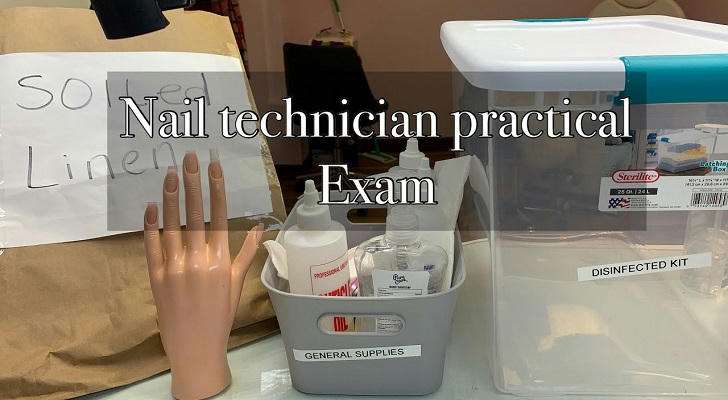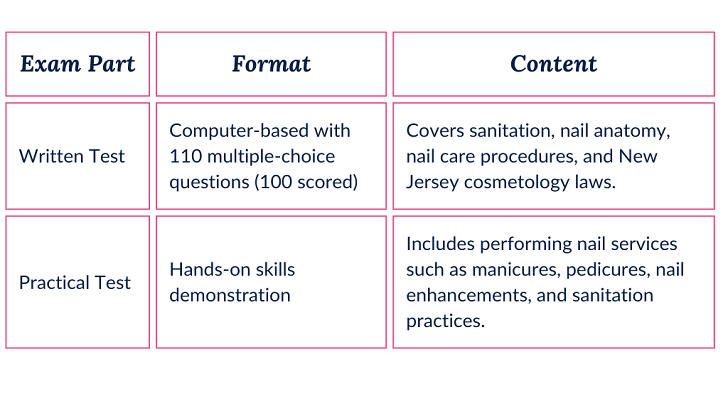How to Prepare for the Nail Technician Exam
A strategic approach to the Nail Technician Exam combines clear understanding of exam structure, disciplined study of core theoretical topics, hands-on practice of practical skills, and smart exam-day preparation. Candidates benefit from reviewing the National Nail Technology Theory Examination outline—40 percent scientific concepts and 60 percent nail procedures—practicing with timed mock tests, and mastering the six practical service domains (setup, manicure, tip, wrap, sculpt, polish). In addition, creating a weekly study plan, using flashcards for key terms, and simulating practical stations under time constraints help build confidence. On exam day, arriving early with proper identification and equipment—including a hand mannequin where required—plus maintaining calm through sound sleep and nutrition completes the preparation.

1. Understand Exam Requirements
1.1 Licensing Body and Exam Format
The written portion of the Nail Technician Exam typically consists of 110 multiple-choice questions administered over 90 minutes, with a passing score set at 75 percent.
The National Nail Technology Theory Examination covers two major content areas: 40 percent scientific concepts (infection control, anatomy, physiology, product chemistry) and 60 percent practical nail technology procedures (client consultation, tool sanitization, manicures, pedicures, enhancements).
1.2 Eligibility and Training Hours
State cosmetology boards require completion of a state-approved nail technician program, which ranges from 300 to 600 training hours depending on jurisdiction.
1.3 Registration and Fees
Registration is handled through each state board’s online portal or designated testing agency, where candidates select exam dates and pay applicable fees; many states publish these details in their candidate bulletins.
2. Create a Structured Study Plan
2.1 Identify Core Topics
Review the official exam bulletin to map out all required domains, emphasizing infection control procedures, nail anatomy, and product chemistry for the theory section.
2.2 Weekly Study Goals
Break the textbook into chapters and assign one to two chapters per week, dedicating consistent time slots for reading, note-taking, and self-quizzing.
2.3 Tracking Progress
Maintain a checklist of topics studied and practice-test scores to identify weak areas and adjust the plan accordingly.
3. Master Written Knowledge
3.1 Use Official Bulletins and Textbooks
Download or request the latest exam bulletin from the NIC or state board website to ensure alignment with current content outlines.
3.2 Practice with Mock Exams
Utilize reputable practice tests—such as those from Mometrix Academy—to simulate exam conditions, first “open book” for comprehension, then timed “closed book” sessions to build pacing skills.
3.3 Flashcards for Key Terms
Create digital or physical flashcards for essential terminology (e.g., “paronychia,” “monomer,” “eponychium”) and review them daily to reinforce retention.

4. Hone Practical Skills
4.1 Required Tools and Setup
Confirm the list of approved tools (clippers, pushers, tip cutters, files) and supplies (mannequin hand, disinfectants) provided in the state board’s practical exam guide.
4.2 Practice Each Service Domain
Dedicate practice stations to the six NIC practical domains—workstation setup and client protection, basic manicure, tip application, wrap application, sculptured nails, and polish application—ensuring familiarity with each procedure’s steps and timing.
4.3 Time Management Drills
Use a timer during mock practicals to simulate exam pressure, aiming to complete each service within or under the allotted time frame.
5. Exam Day Preparation
5.1 Logistics and Materials
Arrive at the testing center at least 30 minutes early, equipped with a valid photo ID, exam confirmation, and all approved implements; electronic devices, large bags, and reference materials are prohibited.
5.2 Physical and Mental Readiness
Ensure seven to eight hours of sleep and a balanced meal before the exam to support focus, and practice brief breathing exercises to manage nerves.
6. Continuing Education and Recertification
Many state boards require periodic continuing education credits or refresher courses to maintain licensure; researching upcoming workshops and online courses helps stay current with industry standards.

Conclusion
Thorough preparation for the Nail Technician Exam weaves together disciplined study of theory, repetitive practical drills, strategic use of mock exams, and calm, organized exam-day execution. By following these evidence-based steps and leveraging official bulletins and reputable practice resources, candidates can approach both the written and practical portions with confidence and poise.
